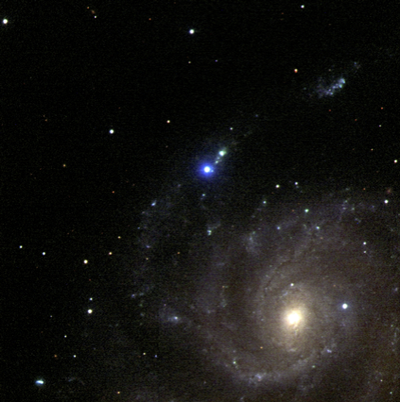
False colour image of supernova SN 2023ixf (bright blue object near centre of frame), made with LT IO:O data taken early in the event. ©2023 Robert Smith, LT Group
One of the closest supernovae in the last decade appeared in our skies a couple of weeks ago. Supernova SN2023ixf was first detected on 19th May in the Pinwheel Galaxy (M101) by amateur astronomer Koichi Itagaki.
Within hours of Itagaki's announcement, LJMU ARI astronomer Dr Dan Perley was able to officially classify the object as a type II supernova, thanks to the LT's flexible scheduling capabilities and instrumentation.
Public access observing campaign
An aggressive 3-month campaign of daily (at first) multi-band LT imaging and spectroscopy is now under way, to follow the evolution of the supernova for as long as it is visible. The observations consist of both IO:O imaging (to follow the color, temperature, and luminosity evolution) and SPRAT spectroscopy (to measure the evolution of velocities and line widths).
In addition, and as a first for the LT, all data is being released to the public immediately. Normally LT data remains proprietary to the investigating team for a year after acquisition.
Dan Perley, the principal investigator of the project, said this move was to avoid the potentially excessive number of requests for followup observations of the same target, which would reduce the efficiency of the LT's adaptive robotic scheduler.
Download your data
The latest SN2023ixf public data can be downloaded right now from the LT's archive of data taken in the last two weeks, at SN2023ixf Recent Data. Use these credentials: username "PQ23A01" and password code "5221533".
Data more than two weeks old can be found with the help of the general Data Archive online form. On the other hand, brand new data arriving overnight can be viewed on the Quicklook page. Data appears here about 5 mins after the shutter closes. It will be reduced with the latest calibration flats the following morning, and exists here just for "quick look" purposes only. It can be accessed with the same credentials as above.
Please note: anyone employing these data in forthcoming circulars or publications are requested to cite the AstroNote where the public announcement was made. Publications should also include the relevant telescope and instrument acknowledgments and citations as set out in our Acknowledgements page.
Legacy
The supernova is only 21 million light years away, so is one of the closest to date. Because it was first observed while still rising to peak brightness, and due to its favourable sky location, it will be one of the best-observed cosmic explosions of all time.
Dr Perley added: "It shares a host galaxy with the famous SN 2011fe and extensive pre-explosion observations are available from HST and other major facilities. It may be the most important core-collapse supernova of the 21st century so far."


